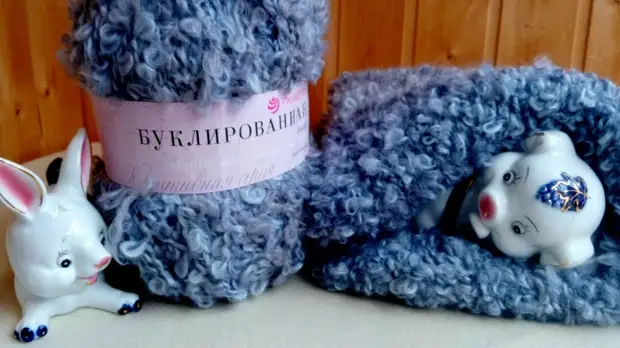
But let's start with the definition of the bookly yarn for those who have no idea about it or very superficially aware of it, as well as focus on its advantages and disadvantages.
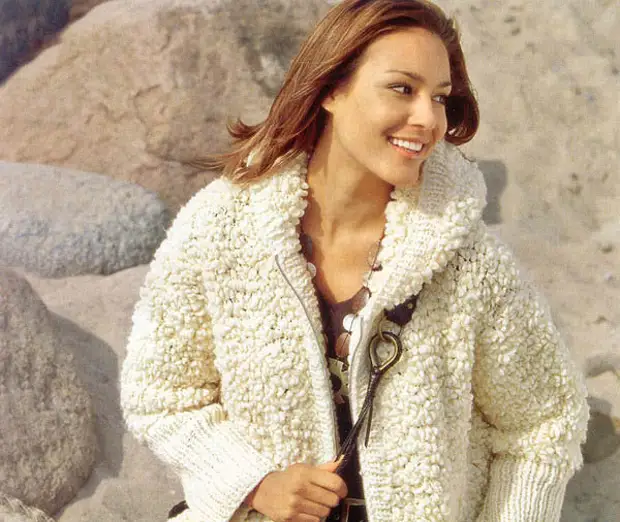
About yarn
The name of the yarn originates from the word "booklet", which is translated from French as "curl" or "curly", "curly". The yarn, of course, not in vain got its name - it consists of a variety of fluffy, air curls, "strung" on the thread along its entire length in a certain or chaotic order. "Curls" from the finest, most advantage of woolen, fibers are obtained by inclusion in the structure of yarn of various nodules, thickens and loops. Thanks to these "curls", it turns out to create soft, warm and pleasant to the touch products that differ in the original texture, volume.
Like the fur yarn, bookly imitates the fur (closer to the doodle), but in the appearance of it hardly confuse from any other.
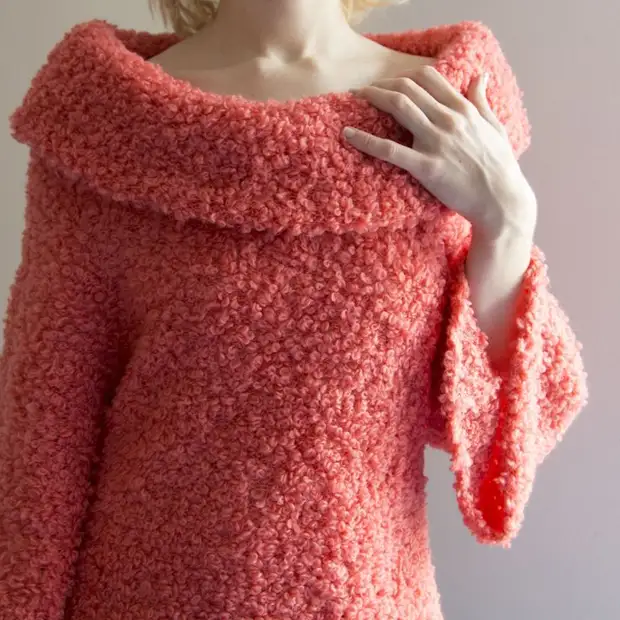
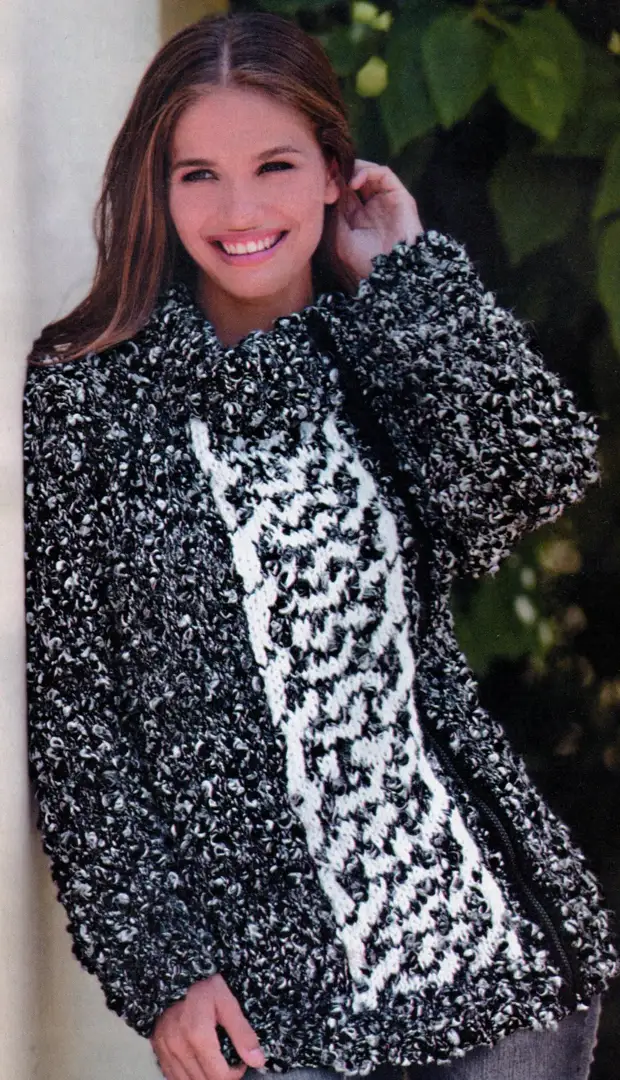
Advantages and disadvantages of booklined yarn
Let's start with the advantages of the booking yarn:
- It is convenient that it is possible to knit from it with a simple viscous (face or invalid, ordinary elastic, columns without an inacid), because the nodules and areas of uneven twists create relief themselves. In addition, complex Arana and openings "crowd out" in these products simply makes no sense - the patterns will not be visible. But even with the most simple viscous items from the bookly yarn look very interesting and effectively.
- The yarn is good because the flaws and errors made by the needlewoman in the process of knitting are usually not visible. But, of course, if they are small.
- For the most part "Book" - a rather thick thread and needles for work are usually used large (more convenient to knit from the book-made yarn). Therefore, such a cloth quickly knives.
- Finished products are well kept form, do not give a strong shrinkage after washing, do not pull during socks, do not need special care.
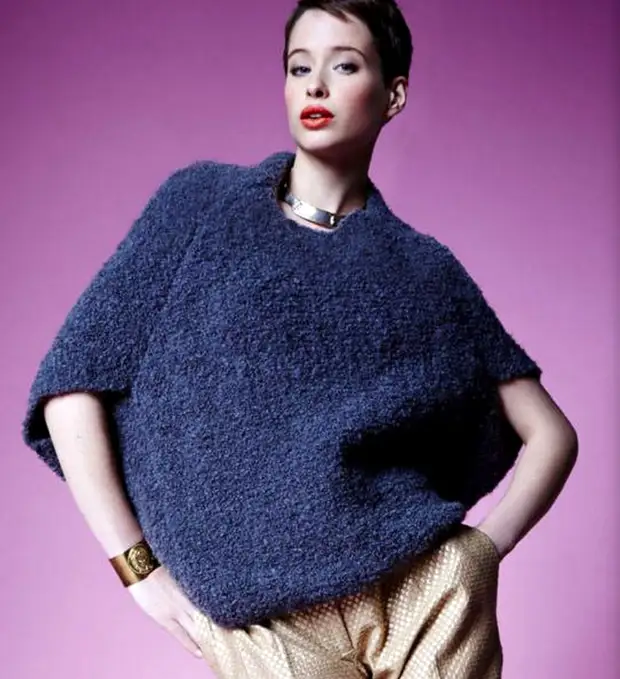
The following items include disadvantages:
- Small strings, of which the yarn consists, can cling to the needles - this is probably the perpetary discomfort. But with the acquisition of the skill, this deficiency disappears.
- Due to the fantasy, the embossed surface of the yarn is easy to get away from the loop account in the knitting process. Therefore, during operation you need to be very attentive. For the same reason, especially at the first pores, it is better to stop its choice on simple shapes, with a minimum amount of gradation and loop reduction.
- Disgrace the product from the bookly woolen yarn is quite difficult and the yarn can then lose its original appearance.
What to tie from the booklined yarn?
From the booklined yarn, a variety of interesting things are obtained. Knitted coats, cardigans, jumpers, sweaters, and often "Oversiza" are very common. When knitting things, knowingly larger, the yarn does not give an undesirable amount, but it benefits this effect favorably.
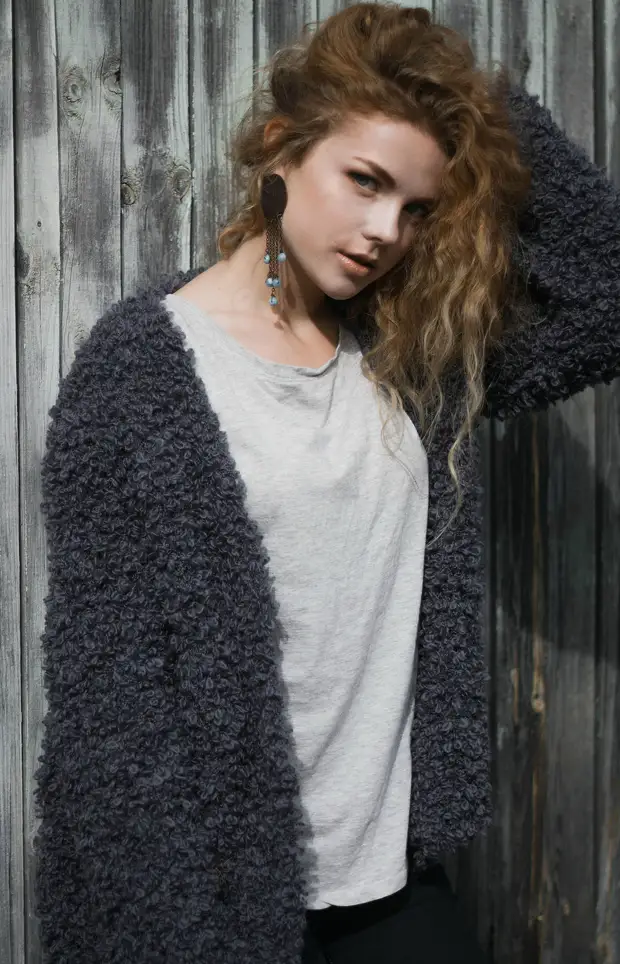
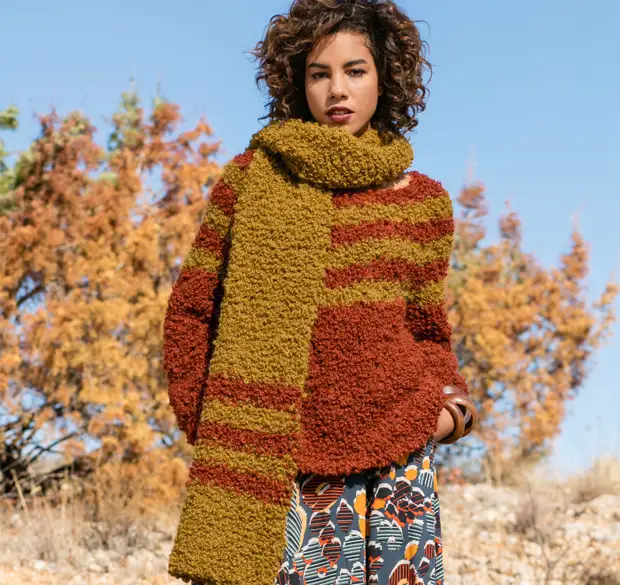
Interesting accessories are obtained from the booklined yarn: hats, scarves, sinks, bags, as well as interior items in the form of plaids, rugs, covered and pillows. And what cute toys from the book-made yarn! Not only baby, but also an adult they will like her! Cute bears, sheep and other animals will become an excellent toy child, a memorable gift for a loved one, a real home interior decoration (and not only a children's room).
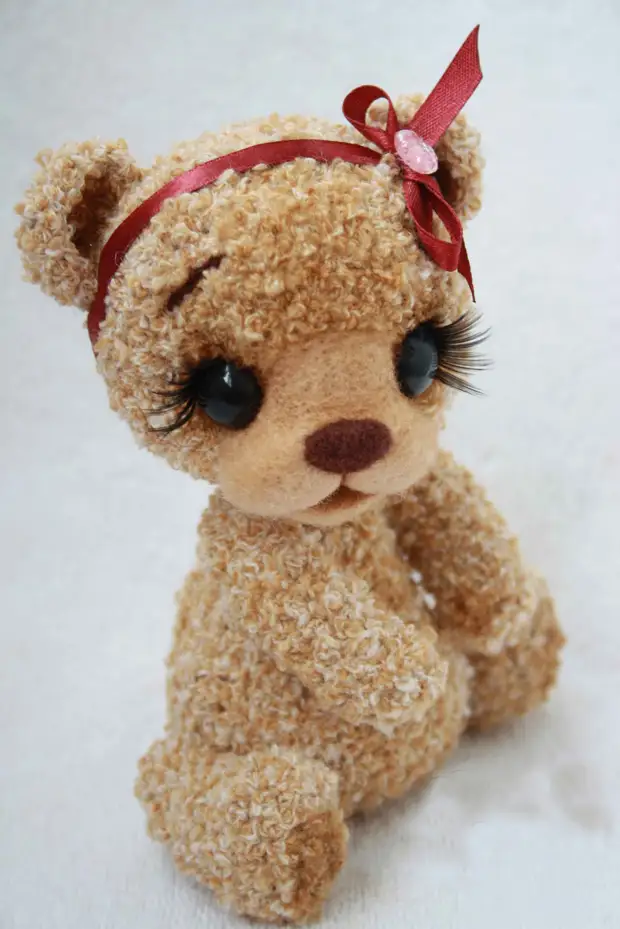
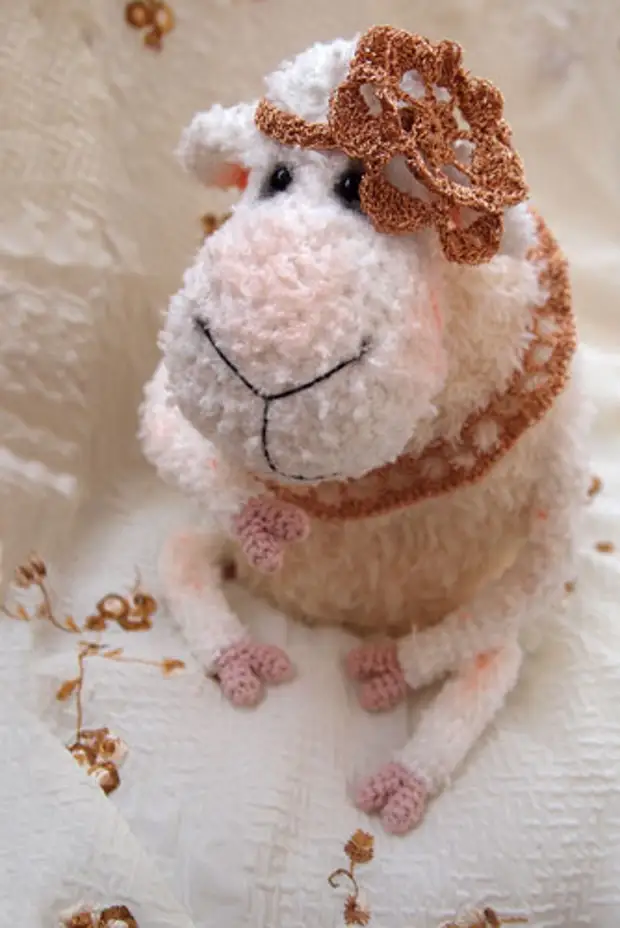
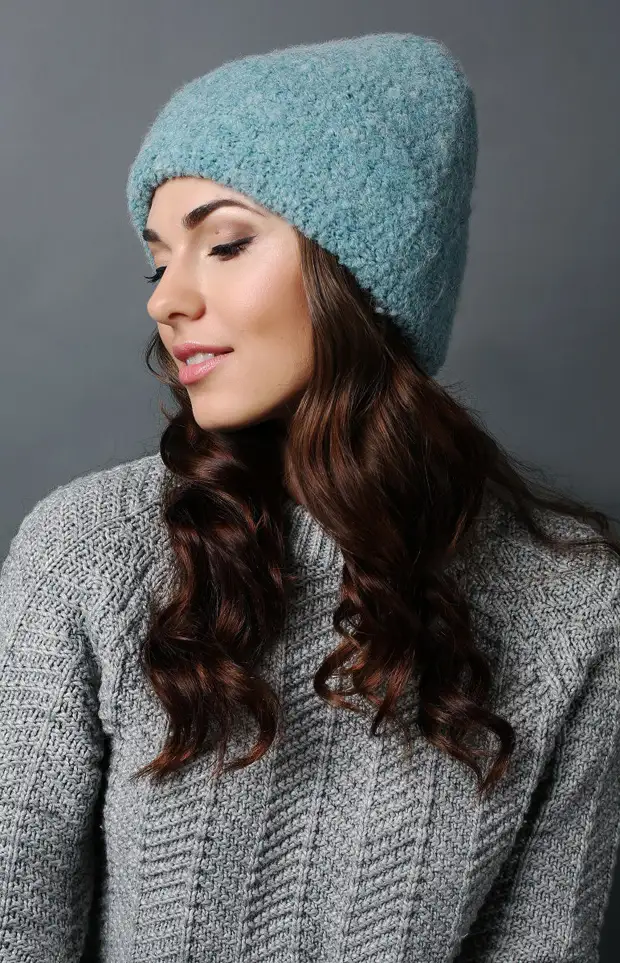
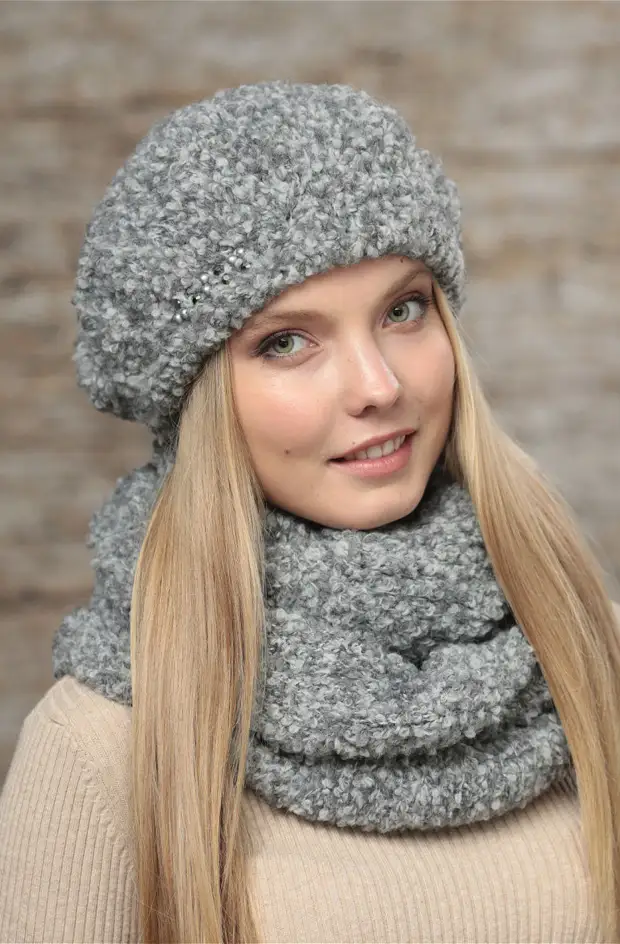
Schemes and descriptions
We picked up for you some interesting models of clothing that can be connected from the booklined yarn. Below you will find patterns of products and knitting descriptions.Surium coat from yarn - book
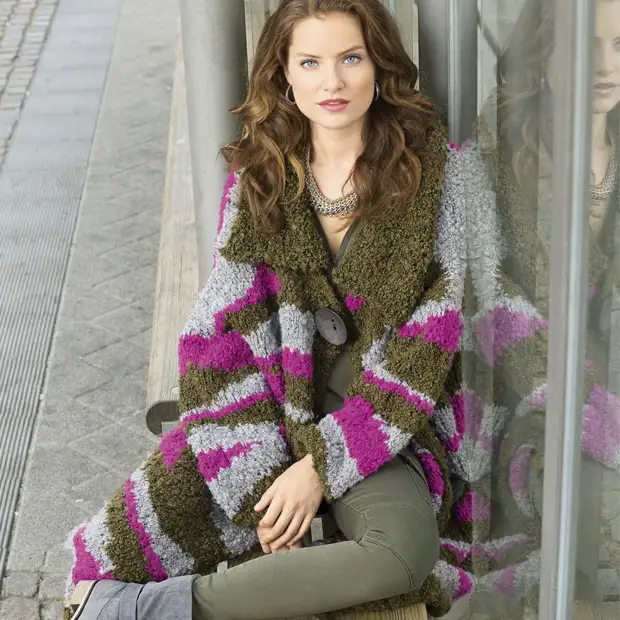
Dimensions
38/44.
You will need
Yarn (40% polyacryl, 30% mohair, 20% natural wool, 10% polyamide; 65 m / 50 g) - 450 g olive, 350 g of light gray and 250 g pink; circular spokes number 7; 6 buttons (diameter 70 mm).
Patterns and schemes
Rubber
The number of loops is multiple 4 + 2 + 2 edges. Each row start and finish 1 edge.
Facial rows: alternately 2 facial, 2 irons, finish 2 facial;
Pouring rows: hinges to lies in the drawing.
Facial smooth
Facial rows - facial loops, invalible rows - invalous loops.
Color Pattern A.
Knit combined. The counting scheme is facechair in the technique of intarspace threads from different balls, while changing the color to cross the thread on the involving side to avoid formation of holes.
The diagram contains facial and invalid rows, including edge for shelves and backs.
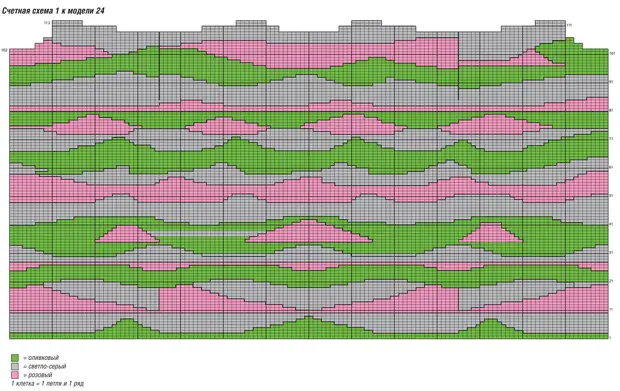
Color pattern B.
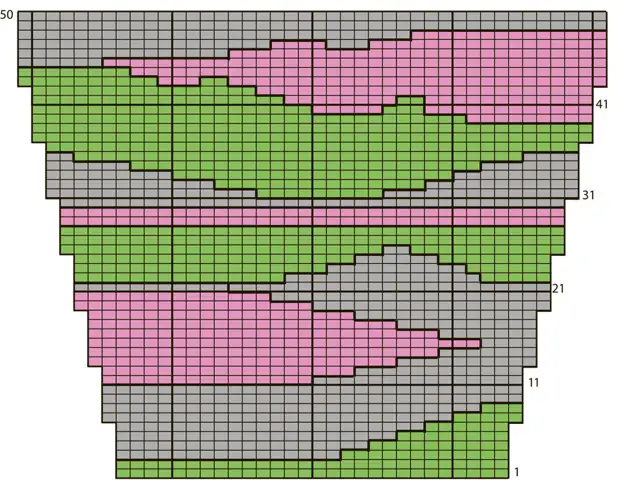
Knitting density
9.5 p. X 13 r. = 10 x 10 cm.
Attention!
Shelves and a back to the premium knit with a single web.
Due to the large number of hinges, we recommend knitting on circular spokes in the rows in the forward and reverse direction.
Pattern
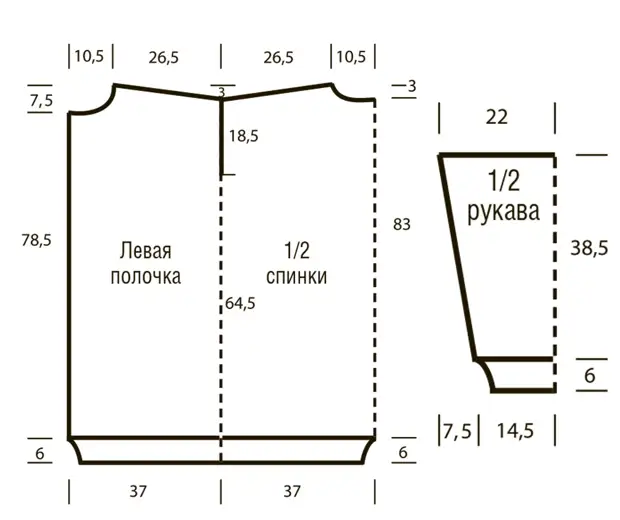
Completing of the work
Shelves and backs
Olive thread to dial 140 hinges on the knitting needles (= 35 loops for the shelves and 70 hinges for the back) and for the plank tie 6 cm with a rubber band.
Continue work with color pattern A.
For a program after 64.5 cm = 84 rows from the plank, leave external 35 hinges for the shelves, respectively, and on the middle 70 loops first continue to knit the back of the Sughdle. Pattern.
After 83 cm = 108 rows from the plank, close for the shoulder beep on both sides 1 x 10 p., Then in the next 2nd row of 1 x 8 p.
Simultaneously with the beginning of the knitting of the shoulder bench, the average 14 p. And both sides finish separately.
For rounding the inner edge, close in the next 2nd row of 1 x 3 p.
After 86 cm = 112 rows from the plank, close the remaining 7 shoulders.
Then include in the work of 35 left hinges for the left shelf and continue the operation of Sogl. Pattern.
After 78.5 cm = 102 rows from the plank, close for the neck along the left edge of 1 x 6 p., Then in each 2nd row 2 x 2 n.
Shoulder SCOS on the right edge to perform as on the back.
At the height of the back, close the remaining 7 shoulder.
Then include in operation 35 left loops for the right shelf and knit in the mirror image.
Sleeve
Olive thread to gain on the needles for each sleeve on 28 loops and tie the bar, as on the back.
Continue work with color pattern V.
At the same time add to the bevel of the sleeve on both sides in each 6th row from the plank 7 x 1 n. Sogl. Scheme = 42 p.
After 38.5 cm = 50 rows from the plank, close the loop light gray thread.
Assembly
Perform shoulder seams.
For a collar olive thread to score on the edge of the neck of 72 loops and tie 6 rows with rubber band, then continue to work with a face. After 27 cm from the beginning of the collar, it is free to close all the loops as the facial.
For slats, olive thread to dial 100 loops on sides of 100 loops and knit with a rubber, while in the 3rd row on the right shelf to perform 6 holes for buttons as follows: Close 3 loops and in the next row again dial.
The first button for the button is made through 4 hinges from the lower edge, the rest - with an interval of 15 p. When the height of the plank is 6 rows, close all loops in the drawing.
Run the seams of sleeves and sew the sleeves, slightly charged. Sew buttons.
Vest with asymmetric line Niza
Free vests with an asymmetric line of Niza are versatile and easy to perform. This model is connected from the soft of the book-bearing yarn with a regular front stroke - easy and simple!
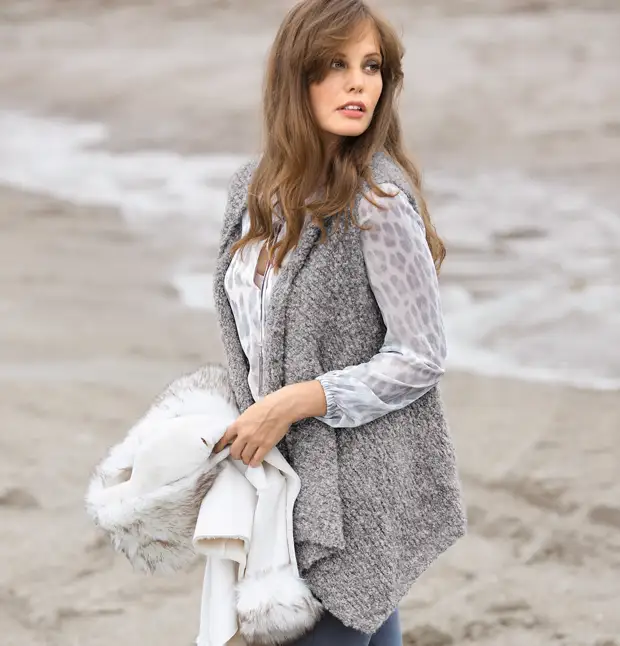
Dimensions
34/36 (38/40) 42/44
You will need
Yarn (70% polyacryl, 10% Alpaca, 10% wool, 10% polyamide; 100 m / 50 g) - 250 (300) 350 g of light gray melange; Circular spokes number 5,5.
Patterns
Facial smooth
Facial rows - facial loops, invalible rows - invalous loops.
Shortened rows
A row to stick to the left loops, then turn the operation with 1 nakid.
Knitting density
13.5 p. X 22 p. = 10 x 10 cm.
Attention!
Vest to the premium knit with a single web. Due to the large number of hinges, we recommend knitting on circular spokes in the rows in the forward and reverse direction.
Pattern
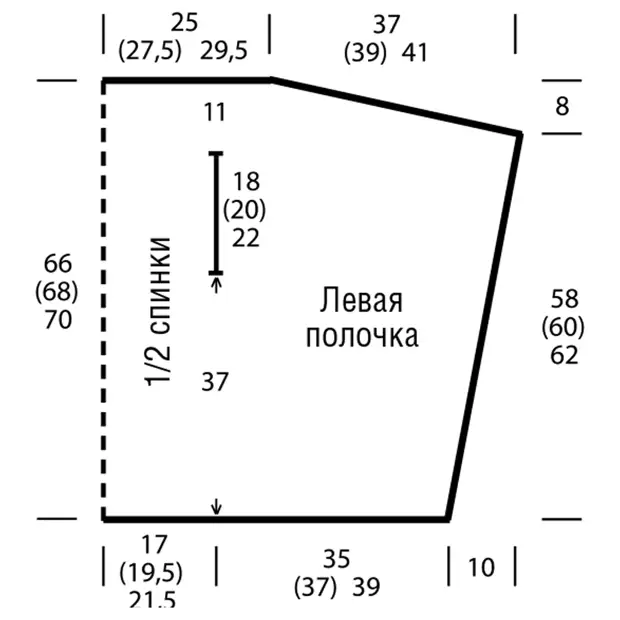
Completing of the work
To dial on the knitting needles 140 (152) 164 loops and knit face, with an outer 47 (50) 53 p. Form the shelves, an average of 46 (52) 58 p. - back.
At the same time, add a shelf for the bevel on both sides in each 8th row from the initial row 14 x 1 p. (In each 8th row 12 x 1 p. And in each 10th row 2 x 1 p.) In each 8 - Row 10 x 1 p. And in each 10th row 4 x 1 p.
At the same time, after 37 cm = 82 rows from the initial row (on the spokes 160 (172) 184 p.) To divide the work for the proy, as follows: 57 (60) 63 p. Right shelf, 46 (52) 58 p. Backs, 57 (60 ) 63 p. Left shelf.
All items continue to knit separately by 18 cm = 40 rows (20 cm = 44 rows) 22 cm = 48 rows, while continuing to perform an increase in the shelf on the outer edge of the shelves.
After 55 cm = 122 rows (57 cm = 126 rows) 59 cm = 130 rows from the initial row, the end is made.
Reong to work on all hinges with a single web. At the end of all additives on the spokes, 168 (180) 192 p.
After 58 cm = 128 of the rows (60 cm = 132 rows) 62 cm = 136 of the rows from the initial row, leave for the upper bevel of the shelf on both sides 1 x 10 p., Then in each 2nd row 8 x 5 p. (3 x 6 p. And 5 x 5 p.) 6 x 6 p. And 2 x 5 p., In this case, knit short-range rows = 68 (74) 80 p.
After 66 cm = 146 of the rows (68 cm = 150 rows), 70 cm = 154 rows from the initial row to tie on all 168 (180) 192 loops 1 facial row of facial, with the presence of a previous or subsequent loop together facial, respectively, to avoid education Power and in the next involve row, close all the loops as the wrong.
Cap and Sand from Booklined Yarn
An excellent set of caps with pompon and a diagonal shed diagonally based on a combination of booklined and smooth yarn. No additional patterns are required to such accessories.
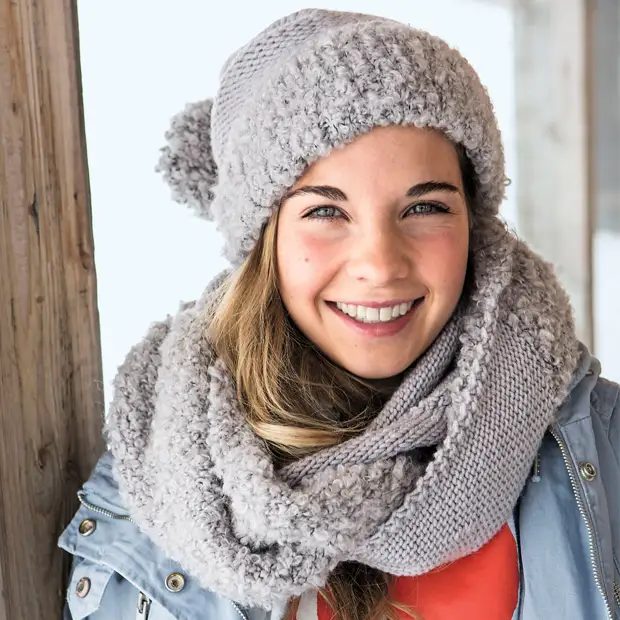
Dimensions
Girth of head 50-52 (54-56) cm
Snad: 25 (when knitting with silver-gray thread) x 147 cm
You will need
Cap: Yarn Lana Grossa "Bombolo" (40% polyacryl, 30% mohair, 20% sheep wool, 10% polyamide; 65 m / 50 g) - 100 g silver-gray book-bearing (No. 17); Yarn Lana Grossa "Bingo" (100% sheep wool; 80 m / 50 g) - 50 g of gray-sirens (№171); Breaking spokes number 6 and 7; Adaptation for pumping pumps.
Snad: Lana Grossa Yarn "Bombolo" (40% polyacryl, 30% mohair, 20% sheep wool, 10% polyamide; 65 m / 50 g) - 150 g silver-gray book-contained (№17); Yarn Lana Grossa "Bingo" (100% sheep wool; 80 m / 50 g) - 150 g of gray-sirensine (№171); Spokes number 6.
Patterns and schemes
Basic pattern
Announced smooth = circular rows: only the wrong loop.
Facial smooth
Circular rows = facial loops.
Strip sequence (sind)
Knit * 44 p. gray-sirens
36 p. silver gray thread
From * Repeat 3 times = 240 p.
Knitting density
16.5 p. X 44 p. = 10 x 21 cm, associated with the main pattern of gray-lilac thread on the spokes No. 6 (measured diagonally);
14 p. X 36 p. = 10 x 28 cm, associated with the main pattern of silver-gray thread on the spokes No. 6 (measured diagonally);
11 p. X 21 circle.r. = 10 x 10 cm, associated with the main pattern of double gray-lilac thread on the spokes No. 7;
10 p. X 18 circle.r. = 10 x 10 cm, associated with a faceless silver-gray thread on the spokes No. 6.
Important
Due to the fact that the sind fit diagonally, the number of rows does not correspond to the data specified in centimeters.
Completing of the work
Cap
Double silver-gray thread to type 50 (54) p., Linges are evenly distributed to 4 spokes (= 12/13/12/13 (13/14/13/14) p. On each needle) and Knit 16 cm facial stroke.
Then go to the knitting needles number 7 and continue the operation of a double gray-lilac thread the main pattern.
At a total height of 12 cm, it is evenly reduced to 5 (6) p. = 45 (48) p. These accommodation to perform 7 (6) times in each 2-circuit. In the same places = 10 (12) p.
The remaining hinges will pull the working thread.
Assembly
The bottom edge of the caps (= connected by silver-gray thread) folded in half, turning on the wrong side, and sew. From silver-gray threads make a pompon with a diameter of OK. 9 cm and sew to the hatpode.
Snud.
On the spokes number 6, the gray-lilac thread to type 50 p. And knit 240 p. The main pattern according to the sequence of the bands, while in each facial row from the right edge after the edge from the broach to encourage 1 facial crossed, and from the left edge the penultimate loop and the edge to lying together face, then all loops close.
Assembly
The initial edge sew with the edge with closed loops.
A source
